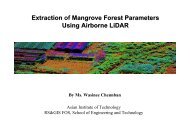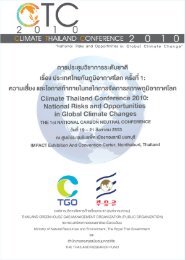Development of a Nature Trail for Ecotourism with Community Participation
Development of a Nature Trail for Ecotourism with ... - TGO Conference
Development of a Nature Trail for Ecotourism with ... - TGO Conference
- No tags were found...
You also want an ePaper? Increase the reach of your titles
YUMPU automatically turns print PDFs into web optimized ePapers that Google loves.
<strong>Development</strong> <strong>of</strong> a <strong>Nature</strong> <strong>Trail</strong> <strong>for</strong><br />
<strong>Ecotourism</strong> <strong>with</strong> <strong>Community</strong> <strong>Participation</strong>:<br />
A Case Study <strong>of</strong> M. 9, Ban Khun Samut Chine Village,<br />
Laem Fa Pha Sub-district, Phra Samut Chedi District,<br />
Samut Prakran Province<br />
Presented by<br />
Mr. Watanachai Chumak<br />
Dhonburi Rajabhat<br />
University<br />
Sustainable Tourism Planning and<br />
<strong>Development</strong> Laboratory
Global warming has affected human beings<br />
Rising temperatures have resulted in rising sea water levels and<br />
coastal erosion.<br />
Ban Khun Samut Chine Temple<br />
Sustainable Tourism Planning and<br />
<strong>Development</strong> Laboratory
C<br />
Coastal erosion areas in Thailand<br />
Gulf <strong>of</strong> Thailand / north<br />
Gulf <strong>of</strong> Thailand / East<br />
Ban Khun Samut Chine<br />
community has been affected<br />
by coastal erosion as it is<br />
located near the Gulf <strong>of</strong><br />
Thailand<br />
GฌGulf <strong>of</strong> Thailand /<br />
West – Upper part<br />
High risk areas<br />
Erosion areas<br />
GฌGulf <strong>of</strong> Thailand /<br />
West – Lower part<br />
AฤฤฟAndaman Sea<br />
Sustainable Tourism Planning and<br />
<strong>Development</strong> Laboratory
Map <strong>of</strong> Ban Khunsamutchine in Year 1952 - 2009<br />
Sustainable Tourism Planning and<br />
<strong>Development</strong> Laboratory
Distance between coastline and the temple<br />
Year From coastline to temple From temple to coastline<br />
( Temple located on land ) ( Temple located in the sea )<br />
1952 360 -<br />
1974 220 -<br />
1991 70 -<br />
2002 - 400<br />
2009 - 360<br />
57 years total land erosion 1. 410 km.<br />
Sustainable Tourism Planning and<br />
<strong>Development</strong> Laboratory
What happened to Ban Khun Sumut Chine?<br />
• Seashores are destroyed by sea water<br />
• Mangrove <strong>for</strong>ests are destroyed<br />
• Shrimp farming concession<br />
• Lack <strong>of</strong> conservative consciousness<br />
• High temperature
Problems are…..<br />
• Lose occupational and residential areas<br />
• Lands were sunk<br />
• Villagers moved houses escaping from<br />
flooding average 3-5 times per person,<br />
maximum 8 times in life time.<br />
• Villagers relocated to another areas.<br />
• The registered population in the<br />
community approximately 400 people,<br />
actually residing in the community is<br />
around 200 people.<br />
• Renting lands <strong>for</strong> residing and<br />
occupation.
How to solve the problems ………<br />
1. Cultivating the mangrove trees (long periods)<br />
2. Building concrete dam (high investment)<br />
3. Promoting people’s awareness in environment conservation<br />
and enhancing the realization <strong>of</strong> the effects <strong>of</strong> global warming<br />
4. Developing the area as an educational tourism center<br />
Sustainable Tourism Planning and<br />
<strong>Development</strong> Laboratory
Ecological system in mangrove <strong>for</strong>est
Ways <strong>of</strong> life
Khun Samut Chine Temple
Chinese Shrine in Village
Develop the nature trail<br />
- Utilize tourism activities as a tool to solve problems in<br />
the community<br />
- A medium <strong>for</strong> raising tourists’ consciousness <strong>of</strong> global<br />
warming and impacts <strong>of</strong> natural resource destruction.<br />
Sustainable Tourism Planning and<br />
<strong>Development</strong> Laboratory
Research objectives<br />
1. To develop a nature trail <strong>with</strong> community participation .<br />
2. To know the opinions <strong>of</strong> the community and tourists on the<br />
trail<br />
The process in developing the trail<br />
1) Survey <strong>of</strong> the trail<br />
2) Workshop<br />
3) <strong>Development</strong> <strong>of</strong> the trail<br />
4) Field trip<br />
5) First try-out <strong>of</strong> the trail<br />
6) Second try-out <strong>of</strong> the trail and evaluation<br />
7) Evaluation and conclusion<br />
Sustainable Tourism Planning and<br />
<strong>Development</strong> Laboratory
Population and Samples<br />
- The community leaders<br />
- The committee members <strong>of</strong> the Conservation Group<br />
- Representatives from the Local Administrative Organization<br />
- Villagers<br />
Instruments<br />
- Action research<br />
- Workshop<br />
- Focus-group discussion<br />
- Training<br />
- Educational tour<br />
- In<strong>for</strong>mal dialogue<br />
- Interactive learning and evaluation<br />
Sustainable Tourism Planning and<br />
<strong>Development</strong> Laboratory
Step 1: Survey <strong>of</strong> the trail<br />
- Found the original trail which is a route <strong>with</strong>in the<br />
village<br />
- Found existing directional signs and signs showing<br />
species <strong>of</strong> aquatic plants and animals<br />
Sustainable Tourism Planning and<br />
<strong>Development</strong> Laboratory
Step 2: Workshop<br />
Training the community….<br />
- How to develop the natural trail<br />
- Roles <strong>of</strong> local guides<br />
- Eco-tourism and sustainable tourism<br />
- <strong>Community</strong> based tourism<br />
Sustainable Tourism Planning and<br />
<strong>Development</strong> Laboratory
Step 3: <strong>Development</strong> <strong>of</strong> the trail<br />
- Transferring community knowledge<br />
- Verifying the in<strong>for</strong>mation<br />
- Preparing the interpretive signs<br />
- Mapping the village<br />
Sustainable Tourism Planning and<br />
<strong>Development</strong> Laboratory
Transferring community knowledge activities
Drawing a map <strong>of</strong> the village
Step 4: Field trip<br />
- Field trip at the Study Center <strong>for</strong> Mangrove Forest Ecosystem<br />
and Environmental Park.<br />
- The trip provided the committee <strong>with</strong> the knowledge <strong>of</strong> and<br />
guidance on developing the trail, which they could apply to<br />
their community.<br />
Sustainable Tourism Planning and<br />
<strong>Development</strong> Laboratory
Field Trip at Study Center <strong>for</strong> Mangrove Forest Ecosystem<br />
and Environmental Park, Prachubkirikhan Province
Step 5: First try-out <strong>of</strong> the trail<br />
• This activity allow the committee applying knowledge<br />
from the training in local tour guides and interpretation<br />
skills.<br />
• These tour guides not familiar <strong>with</strong> the route<br />
• Too much concerned about time<br />
• Uncertain about the in<strong>for</strong>mation<br />
• Lack <strong>of</strong> skills in communication<br />
Sustainable Tourism Planning and<br />
<strong>Development</strong> Laboratory
Try-out trip # 1
Step 6: Second try-out <strong>of</strong> the trail<br />
• Adjustments based on the recommendation from the first try-out.<br />
• The result shows that community have better skills<br />
For example;<br />
• Allowing visitors to express opinions and participate in problemsolving<br />
and natural resource conservation<br />
• Demonstrating how to breed the mangrove seedlings,<br />
• Cultivating the mangrove trees in the area<br />
• Educating about local wisdom<br />
Sustainable Tourism Planning and<br />
<strong>Development</strong> Laboratory
Try-out trip # 2
Map <strong>of</strong> Ban Khunsamutchine nature trail
Global warming effected interpretation<br />
Sustainable Tourism Planning and<br />
<strong>Development</strong> Laboratory
Ecological system interpretation<br />
Sustainable Tourism Planning and<br />
<strong>Development</strong> Laboratory
Historical and cultural interpretation<br />
Sustainable Tourism Planning and<br />
<strong>Development</strong> Laboratory
Interpretive signs
Step 7: Evaluation and conclusion<br />
• <strong>Community</strong> agrees <strong>with</strong> trail development<br />
• Learn new things despite being born and growing up in the area<br />
• Build good relationship among the community members<br />
• Increase the number <strong>of</strong> members <strong>of</strong> the Ban Khun Samut Chine<br />
Conservation Group.<br />
• Establish good relationship <strong>with</strong> local government agencies<br />
• <strong>Community</strong> realize the value, importance and benefits <strong>of</strong> the<br />
mangrove <strong>for</strong>est.<br />
• <strong>Trail</strong> development lead the community into self-reliance.<br />
• The trail raise the consciousness <strong>of</strong> natural resource conservation and<br />
<strong>of</strong> the seriousness <strong>of</strong> global warming<br />
Sustainable Tourism Planning and<br />
<strong>Development</strong> Laboratory
Thank you <strong>for</strong> your participation.<br />
Sustainable Tourism Planning and<br />
<strong>Development</strong> Laboratory








